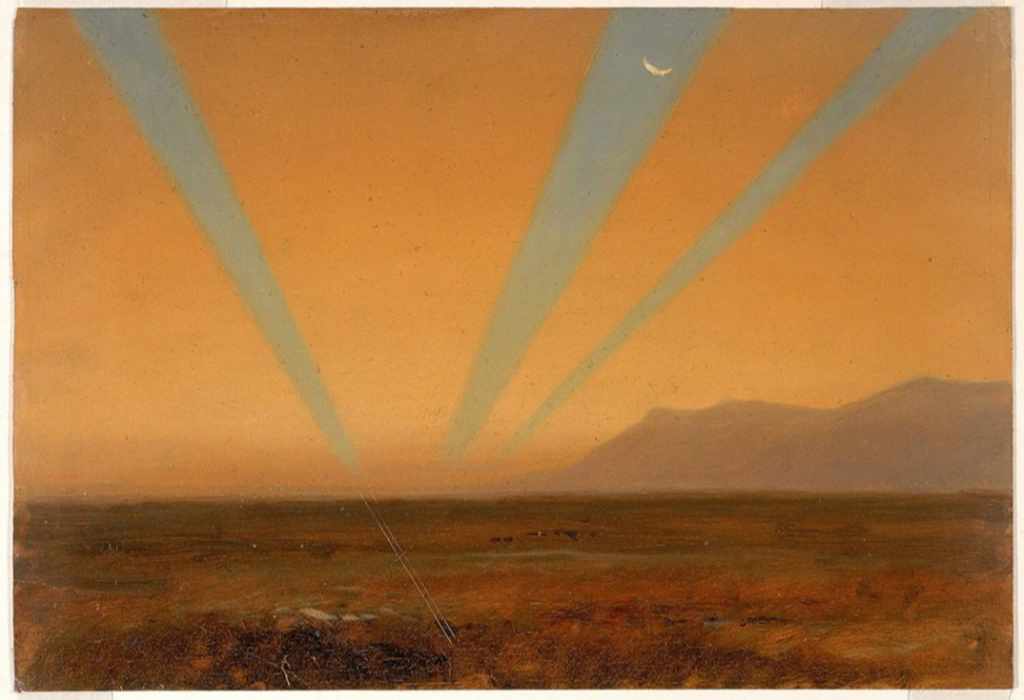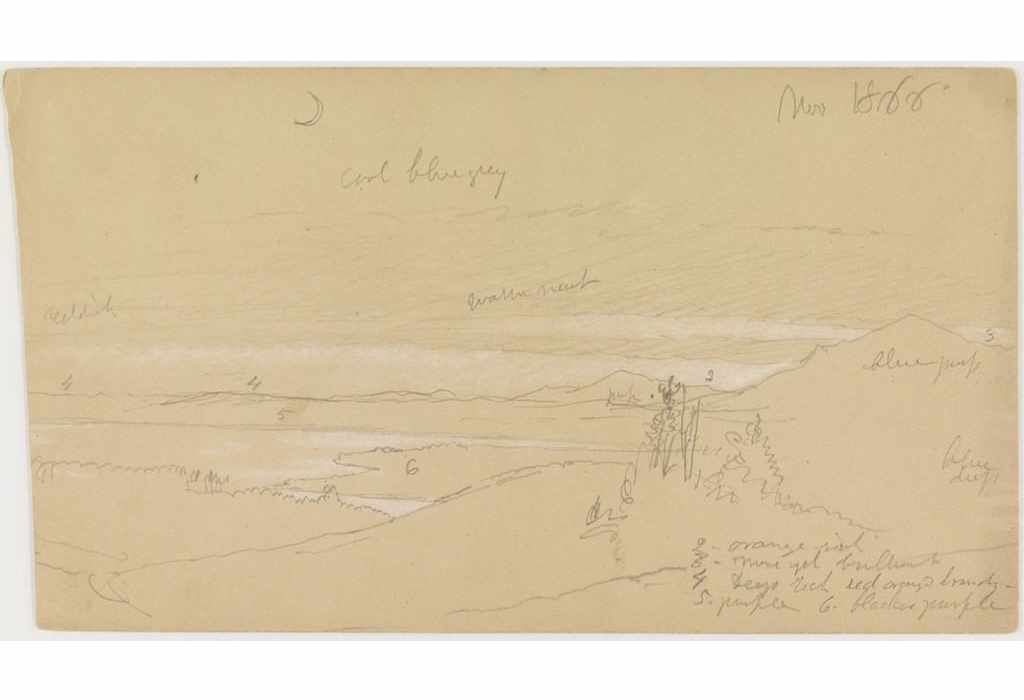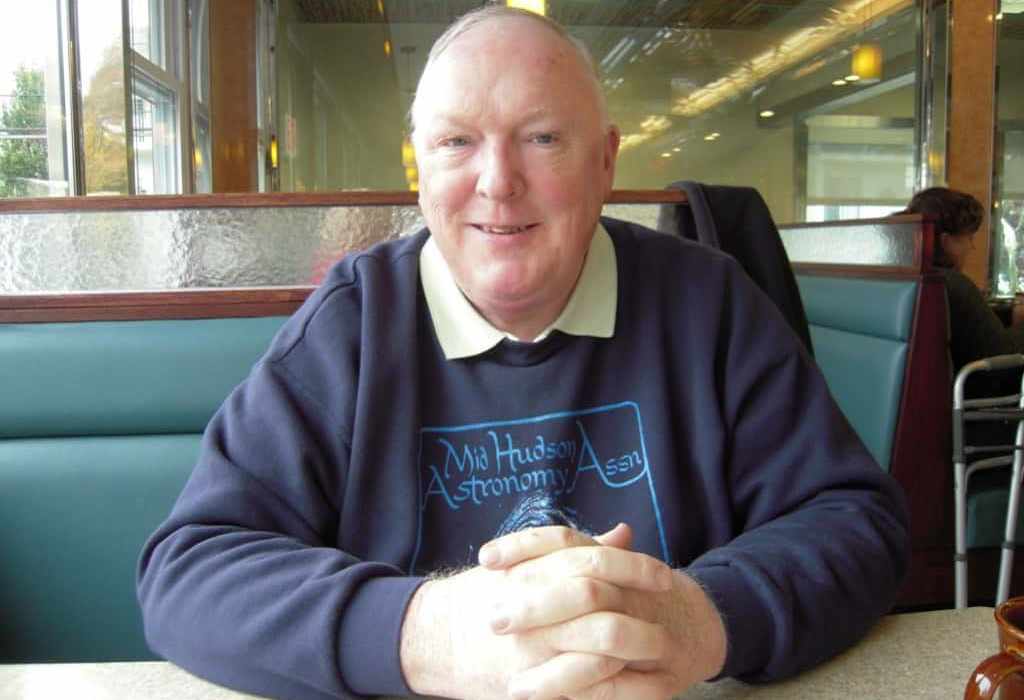Proof that Church’s “Moon in Crepuscular Rays” Actually Was Done From Olana Hill, And Is a Record Setting Sighting of an Old Moon
Amy Hufnagel, Director of Education
What does that title mean? If you are unsure, like me, then here is an insider view of how I learned more about Frederic Church’s 1866 moon sketches, paintings, old moons, and Crepuscular Rays with the help of my colleagues and the general public!
Few celestial sights are as arresting and beautiful as a slender crescent moon. Honestly, I can say that was about the end of my appreciation and knowledge until Karl Loatman visited Olana. Now I see the crescent moon, the history of moon phases, and Church’s moon sketches and paintings, in new terms.
Karl Loatman is the Director of the Mid-Hudson Astronomical Association and resides in Poughkeepsie, NY. Loatman visits Olana a few times a year and is one of many amateur astronomers who work to keep the Astronomical Association, sky appreciation, and land preservation (to reduce light pollution) thriving regionally. Loatman is a great resource to our audiences here at Olana during our very popular and on-going Skyscape Exploration series.
During one of his presentations at the Wagon House Education Center, Mr. Loatman used Frederic Church’s “Landscape with Sunset” (as Cooper Hewitt Smithsonian named it) or “Moon in a Crepuscular Ray” (as Atmospheric Optics, UK named it) to illustrate Church’s interest in astronomy. But that evening an attendee told Mr. Loatman that art historians had doubts about where this had been painted and what it was; historians thought the painting was a study for his painting Aurora Borealis or a sunset seen by Church during his travels in Ecuador and Jamaica. This opinion jolted Loatman to continue researching and join many who have speculated about Church and his interest in the sky (in scientific terms). What is compelling to me as the Director of Education is how an attendee from a public program connected his inquiry from the Education Department with the Curatorial team. Associate Curator Valerie Balint and Archivist Ida Brier reviewed Olana’s archives to answer Mr. Loatman’s interesting questions: Did Frederic Church have binoculars? Was he at Olana in November and December of 1866? What is known about Church’s interest and access to books about optics or merchants selling optical instruments? The link between the public program, the collection, and Loatman’s ideas started to come into focus.
When it comes to sighting the thinnest waning old crescent in the dusk sky — we are no longer talking about a bewitching sight that you might notice casually as with the new moon I spoke of earlier. Spotting such a Moon is no accident — you have to plan for it very carefully and pay close attention to the astronomical conditions under which a record sighting is even possible. The record for sighting the oldest moon was 16 hours and 12 minutes before new moon by André Danjon on August 13, 1931 with a small telescope. But perhaps there is an interesting exception to this, because Loatman is very sure Frederic Church set an earlier record of only 8 hours and 5 minutes (whether he knew how rare it was or not).
Loatman says “the new waxing crescent moon never appears to the right of the sunset point in the Northern hemisphere (this would happen only in a place like Ecuador, Mexico or other southern hemisphere locations). The rays cannot be anti-crepuscular because crescent moons do not appear opposite the sun.” Loatman goes on to say, “Church’s portrayals of nature were usually so accurate that it is difficult to believe that he got it wrong (crescent moon and Crepuscular Rays at same time).” And the more time Loatman spent looking deeply at Church’s art, the more he was sure it was painted from Olana and Church was recording a rare astronomical occurrence. (Notation: Crepuscular rays are defined as “rays of sun light in low light skies. The name comes from their frequent occurrences during the twilight hours around dawn and dusk, when the contrasts between light and dark are the most obvious. Crepuscular comes from the Latin word “crepusculum”, meaning “twilight.”)
To aid his inquiry, Loatman learned about a NASA software system that was recently added to Stellarium, a free, downloadable program that creates a realistic view, in 3D, of the sky. Using this new moon related software he could view every moon cycle, according to days and dates and times, backwards through the 19th century. He looked at titles and dates of paintings, checked out more books from the library to figure out where things were painted, on what date, and linked Frederic Church’s painting, through software, to the actual rare astronomical occurrences of new moons and Crepuscular Rays.
Upon checking moon positions from NASA calculations it became apparent that the new Moon of December 7th, 1866 was a prime suspect. “River through Mountain Valley with Sky and Crescent Moon, November 1866” depicted the start of the same lunar month, also painted by Church; which meant, to Loatman, that Church was very intentionally painting moon phases, not a singular moon event. “It’s just too perfectly lined up to be ignored.” To Loatman, it looks like Church’s paintings and sketches are a record for sighting a waning crescent moon, just 8 hours and 5 minutes before the new Moon of December 7th, 1866. The only way Church could have done this is the luck that the moon was in the dark crepuscular ray shadow and he must have had a decent pair of binoculars or telescope.
“Church’s sketch depicts the South Western sky at 4:20 PM December 6th 1866 from Olana Hill (two years before he built the house). This was just as the Sun set and the Moon was to follow a bit less than 6 degrees after it. Typical binoculars can see a patch of sky about 6 or 7 degrees wide. (Notation: This is based on an analysis with Stellarium software and NASA Phases of the Moon of that art work and “The Hudson Valley and the Catskills from Olana” with sunset positions, as well as “Landscape of mountain valley, river, moon; notations, dated November 1866″ says Loatman. This correlated well with the sketches of the “Setting Positions at Olana by Frederic Church 6/19/1890 to 1/1/1891″and the photo of Church’s binocular case. (OL.1977.172 OL.1977.148 OL.1977.187)
I feel glee when a public program inspires the public to think deeply about ideas that inspired Church. I am also excited to add a personal understanding of moon observations to the list of clouds, comets, aura borealis, and sun activities that Church documented with the scientific reverence that I have spent my life admiring. It is ideal when there is synergy between the public, partner organizations, public programs, curatorial expertise, and new ideas about Church and his world. Visit one of our public programs soon and imagine what might happen next!






